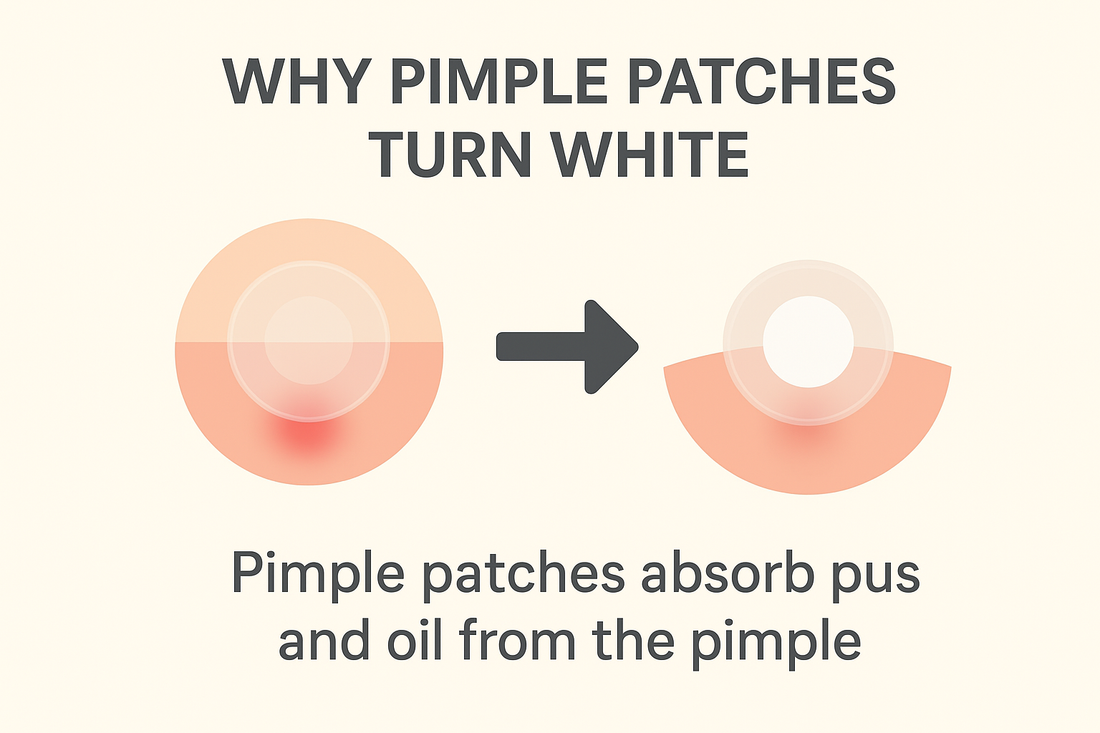
Why Do Pimple Patches Turn White? Dermatologist Explains
Share
You go to bed with a tiny, transparent pimple patch—and wake up to find it turned white overnight.
If you’ve ever wondered, “Why do pimple patches turn white?”, you’re not alone. Thousands of skincare lovers have noticed this transformation but don’t fully understand the science behind it.
Let’s break down what’s really happening under that patch—and how that white color actually means it’s doing its job.
What Exactly Are Pimple Patches?
A pimple patch, also called an acne patch or hydrocolloid patch, is a small, round sticker designed to speed up wound healing and protect your acne from bacteria and irritation.
They’re made with a hydrocolloid dressing—a moisture-absorbing material originally used in hospitals for wound care.
✅ Main Purposes of Pimple Patches:
-
Absorb pus, oil (sebum), and exudate from pimples
-
Protect the spot from bacteria (Propionibacterium acnes)
-
Prevent picking or touching, which can worsen inflammation
- Promote faster healing and reduce post-acne marks
How Hydrocolloid Patches Work

Hydrocolloid patches create a moist healing environment.
When placed over a pimple:
-
The hydrocolloid material absorbs fluids (pus, oil, dead skin cells).
-
It traps this moisture inside, helping flatten the pimple.
-
It forms a gel-like substance—that’s what turns white.
So, that milky-white patch is actually proof that it’s been pulling out impurities and absorbing exudate.
💡 Dermatologist insight:
“The white color indicates the hydrocolloid has interacted with fluids from the pimple—it’s a sign the patch is actively drawing out pus and protecting the wound,” explains Dr. Alyssa Tan, a board-certified dermatologist.
Why Do Pimple Patches Turn White? (The Real Reason)

Here’s the science simplified:
-
When you apply a pimple patch, it seals the pimple.
-
Inside the patch, hydrocolloid starts absorbing pus, oil, and exudate.
-
As these fluids get absorbed, they turn the patch white and opaque.
That white layer is the gel formed by the absorbed fluid.
The more fluid inside your pimple, the whiter the patch becomes.
So, the white color = proof of absorption.
What Happens Inside the Patch
Let’s break it down step-by-step:
|
Stage |
What Happens |
Visual |
|
1️⃣ Initial |
Patch is transparent |
Clear |
|
2️⃣ Mid-stage |
Patch absorbs fluid |
Turns cloudy |
|
3️⃣ Final |
Patch full of pus/oil |
White and opaque |
This process shows that the hydrocolloid has successfully drawn out impurities—like pus, dead skin, and excess sebum—from your whitehead or popped pimple.
Signs Your Pimple Patch Is Working
-
Patch turns white or milky
-
Pimple looks flatter or less red
-
Pain and swelling are reduced
-
No more visible pus on the surface
If your patch stays clear after several hours, it likely means:
-
The pimple didn’t have surface-level pus yet
- You may have used it too early (on cystic acne, for example)
How Long to Leave a Pimple Patch On
For best results:
-
Leave it on 6–8 hours or overnight.
-
Replace it once it turns white.
-
Avoid reusing or touching the patch.
🧴 Pro Tip:
Apply on clean, dry skin after facial cleansing and before moisturizer.
Are Pimple Patches Safe for All Skin Types?
Generally, yes—hydrocolloid acne patches are safe for most skin types, even sensitive or acne-prone skin.
However:
-
If you have a latex allergy or sensitive barrier, check for patch ingredients like adhesives or added actives (salicylic acid, tea tree oil, niacinamide).
-
Avoid using them on open wounds or cystic acne deep under the skin.
⚖️ Hydrocolloid vs. Salicylic Acid vs. Microneedle Patches

|
Type |
Best For |
How It Works |
Turn White? |
|
Hydrocolloid Patch |
Whiteheads & surface pimples |
Absorbs pus & oil |
✅ Yes |
|
Salicylic Acid Patch |
Active breakouts |
Exfoliates & unclogs pores |
❌ No |
|
Microneedle Patch |
Cystic or deep acne |
Delivers actives below skin |
❌ No |
💬 Dermatologist Tip:
“Hydrocolloid patches are ideal for post-inflammatory acne—they manage fluid and reduce trauma, while salicylic or microneedle versions work deeper.”
💡Expert Tips for Using Acne Patches Effectively
-
Cleanse first – Use a gentle, pH-balanced facial cleanser.
-
Dry skin completely – Moisture prevents proper adhesion.
-
Apply before skincare – Don’t layer serums or oils first.
-
Use the right size – Patch should cover the whole pimple.
-
Leave it overnight – Allow maximum absorption time.
- Remove gently – Peel off slowly to avoid skin damage.
⚠️ Common Mistakes to Avoid
-
Using on deep cystic acne (patch can’t reach fluid).
-
Applying over wet skin.
-
Layering over creams or moisturizers.
-
Leaving on too long (can irritate).
- Expecting instant results after one use.
💬 When Pimple Patches Don’t Work — and Why
If your patch doesn’t turn white, here’s why:
-
The acne is not yet “ripe” (no surface pus).
-
It’s a hormonal or cystic pimple deeper in the skin.
-
You applied moisturizer first, reducing adhesion.
Try microneedle or salicylic acid patches for deeper breakouts.
🌙 Best Time to Apply Pimple Patches (Day vs. Night)
|
Time |
Pros |
Cons |
|
Daytime |
Protects from touching & bacteria |
Visible (unless transparent) |
|
Nighttime |
Best absorption & healing |
May fall off with movement |
💡 Pro tip: Use transparent patches for daytime and thicker hydrocolloid patches overnight.
🧴Recommended Products & Dermatologist Insights
Dermatologist-approved, effective options include:
-
COSRX Acne Pimple Master Patch – classic hydrocolloid patch
-
Hero Cosmetics Mighty Patch Original – strong adhesion
-
Rael Miracle Patch Invisible Spot Cover – great for daytime use
-
Peace Out Acne Healing Dots – contains salicylic acid + retinol
🩺 Expert quote:
“Choose simple hydrocolloid-only patches for sensitive skin. Active-infused versions are great but may irritate if used too frequently.” – Dr. Mira Shah, MD, Dermatology
FAQs
Why does my pimple patch turn white overnight?
Because it’s absorbing pus, oil, and exudate from your pimple. The hydrocolloid reacts with moisture and turns white when full.
Does a white patch mean it worked?
Yes! The white color indicates it successfully absorbed impurities and protected the spot.
How long should I leave it on?
Usually 6–8 hours or overnight for best results.
Can pimple patches cause irritation?
Only if you’re allergic to adhesives or added actives like salicylic acid or tea tree oil.
Can I use them on cystic acne?
They’re less effective on cystic acne because fluid lies deeper below the surface. Try microneedle or salicylic acid patches instead.
Are they safe during pregnancy?
Most hydrocolloid-only patches are safe, but avoid active ingredients unless dermatologist-approved.
